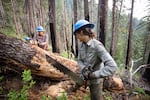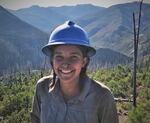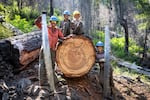“How hard could this be?” Tiffani Aryes wondered when she read the description for a summer internship on a trail crew in the remote wilderness of Southwestern Oregon.
Having hiked trails before, she imagined the work being as basic as “throwing a stick aside on a trail and hiking on.”
The internship, offered by the non-profit Siskiyou Mountain Club, was paid, and Aryes needed to earn money to start college in the fall.
The Siskiyou Mountain Club’s Wilderness Conservation Corps internship promised a monthly stipend, performance bonuses and the reward of hard work. Aryes had no idea exactly how hard the work would actually end up being, or how profound the personal reward would be.

Tiffani Aryes learns the skill of cutting logs with a two-handle crosscut saw during her summer internship with the Siskiyou Mountain Club.
Siskiyou Mountain Club
The new crew
A week after graduating from Ashland High School, Aryes found herself on a small crew of new recruits. She was the youngest at age 18, and the only one from Oregon.
She felt anxious because she didn’t own any backpacking gear and couldn’t afford to buy new equipment. Siskiyou Mountain Club helped with some loaner gear and a scholarship. Before heading into the backcountry, the crew stopped at a Goodwill and enjoyed picking out work shirts and heavy pants.
The internship started with eight days of training. Aryes realized she was in for far more intense work than she had ever imagined — the labor of clearing brush, digging trail beds and sawing giant logs with antique crosscut saws promised a summer of sore muscles and blisters.
But Aryes found encouragement in the words of Siskiyou Mountain Club co-founder and executive director, Gabe Howe.
“He gave us no illusion that it would be easy,” Aryes said, “but Gabe made it inspiring, like trail work was important.”
Howe is passionate about trails. In 2006, he and his wife, Jill, were hiking in the Kalmiopsis Wilderness in Curry County after the massive Biscuit Fire. Finding the trail system wiped out, and the Forest Service without a budget to restore hundreds of miles of trails, the Howes took the mission on themselves. With family and friends, they formed the Siskiyou Mountain Club in 2010.
In 2014, they created the Wilderness Conservation Corps program to create opportunities for youth to get hands-on skills, build their professional resumes and, most importantly to Howe, experience the transformation of trails. “You shape the wilderness,” Howe said, “and in turn, it shapes you.”
Into the wildlands
Aryes and the new crew found themselves packed into a van, rattling up a primitive dirt road. After several dusty, bumpy hours, they unloaded at the trailhead and hefted their packs onto their shoulders, laden with camping gear and food for a week in the backcountry. Because they were entering federally designated wilderness in a national forest, they could not bring any chainsaws or power tools. Instead, they carried heavy wood and steel tools like axes, Pulaskis and two-person crosscut saws — the type lumberjacks used in the 19th and early 20th centuries.
The Wilderness Conservation Corps trail crews backpack into remote project sites and work from wilderness areas for eight days at a time. It can take over a day just to hike to the work site.
Aryes had done day hikes before, but had never trekked so deep into the backcountry. At night, she’d look up at the Milky Way. Once, she saw a herd of elk and felt a pounding thunder as they ran away.
After a few days, she no longer thought about her phone. Her world became only the small crew and the daily routine of the work. After a week of gritty labor and no showers, she could identify her crew mates by their scent. In snapshots, her face is coated in trail dust, her smile wide and beaming.

Tiffani Ayres smiles while working deep in the Siskiyou Wilderness of Southwestern Oregon. Wilderness Conservation Corps crews spend eight days at a time in the backcountry doing gritty work to restore trails.
Siskiyou Mountain Club
Finding family
Aryes said she had felt shy and introverted at the start, and had hoped joining the crew would help her come out of her shell.
“This generation has been locked down in COVID,” said Howe. “When they get into the wilderness together on a trail crew, their interpersonal skills grow.”
The interns did not need experience to join the crew, Howe told them; he promised they’d get training in the field. Aryes soon found herself wielding heavy tools and learning the nearly lost art of working the crosscut saw, nicknamed a “misery whip” by the old time lumberjacks.
“When you’re cutting logs that could harm you in so many ways, you have to be confident in your decisions,” said Aryes. “I had to learn to be responsible and assertive in my decisions. And to be aware of others around when cutting such big logs.”
By the last day of her first eight-day work “hitch” in the Kalmiopsis Wilderness, Aryes missed fresh salads and smoothies. Getting back to town, she appreciated a warm shower like she never had before.
On the four days off in between each work hitch, the crew stayed at developed campsites near towns. The Siskiyou Mountain Club provided transportation for resupply trips and other shared activities.
Some crew members quit after the first hitch, leaving those who remained feeling even tighter in their bonds.
“You’re beat and tired at the end of the day, but you’re beat and tired together,” Aryes said.

Crew members of the Wilderness Conservation Corps in the Siskiyou Wilderness on the job in a federally designated wilderness area. The crew uses hand tools like 19th century crosscut saws to cut through massive old-growth logs.
Trevor Meyer
Sweet reward of sweat
The stipend and performance bonus helped Aryes save for her first year at the University of Oregon. In addition to the pay, interns receive credentials from the University of Montana’s Arthur Carhart Wilderness Institute, the Center for Leave No Trace Outdoor Ethics and the U.S. Forest Service, as well as a certificate of service recognized by the National Corps Network to put on college applications or resumes.
“When you calculate the hourly rate, it’s not a lot given the hours, but it’s totally worth it,” Aryes said. “You can’t really find many jobs out there to be paid to go out into a wilderness with breathtaking views. The people and views outweigh the physical.”
By the end of the summer, Aryes was the most physically fit that she had ever been, but she’d learned that the work was more about mental fortitude than physical size or muscle strength.
“There were people who were physically stronger going into the summer, but who quit,” she said. “You get physically stronger, but it is more about mindset with the Siskiyou Mountain Club. I transformed into someone more confident.”
This summer, Aryes will come back as assistant crew leader. Since her first summer working on the trail crew, she can’t imagine spending this summer in an air-conditioned room, she said with a chuckle.
“The work is addictive,” she said. “You want to get back out there and work as hard as you can.”
The Siskiyou Mountain Club is currently accepting applications for internships that start on May 1, June 6 and June 29.
